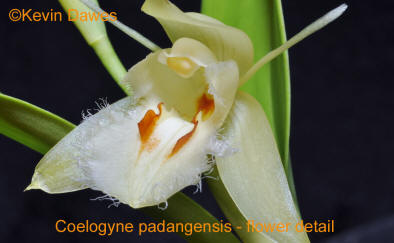This plant is not readily available in Australia at this stage despite being described back in 1911. This variant, has a really nice flower but is extremely straggly and needs lots of space.
Dr Barbara Gravendeel, a Dutch expert, suggests that this Coelogyne, along with a number of others should all be renamed as Coelogyne fimbriata. On my page for Coelogyne ovalis is an image of this plant labeled as Coelogyne ovalis 'China'. I strongly feel that this plant is incorrectly labeled. I think it is Coelogyne pandangensis which in turn should be relabeled as Coelogyne fimbriata according to Dr Gravendeel. You (like me) should be totally confused by now! Without any scientific backup, I have placed the images on this page in the context of all of this confusion. One day I may have to re-label it as Coelogyne fimbriata.
It supposedly comes from Sumatra but apparently is found up to 1200 metres
which should indicate that it is not fully tropical. However, it should need
lots of humidity and not frost. None of this explains why my flowering plant
(Coelogyne ovalis) is labeled 'China'!
Note the propagation technique I have used in the first image
above. With cuttings like this with many psuedobulbs on long 'runners' it is
very difficult to fit them into a standard pot. I have filled the pot with
high moisture retaining material (sphagnum moss is good or coco husk as in
the image) and wound the runner around the inside of the pot using clips to
hold it in place in contact with the moss and not allowing any movement of
the cutting. An alternative is to tie the cutting onto a slab of timber or
fern with sphagnum moss either under of over the runner. This method works
well in a humid, damp environment but is at risk of drying out if the
humidity drops. Negatives: The flowers are small and not massed
to produce a showy display and it is an extreme rambler. Rating: ♦♦♦ I find this flower, whatever its name,
to be a really attractive variation. It seems as easy to grow as any
other form of Coelogyne fimbriata. Sometimes sold as: Coelogyne ovalis Varieties: None known Hybrids: None registered
| < Coel pachystachya | Coel pandurata > |
